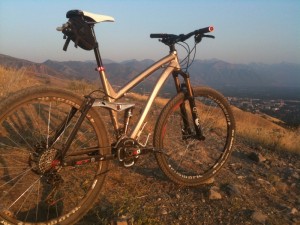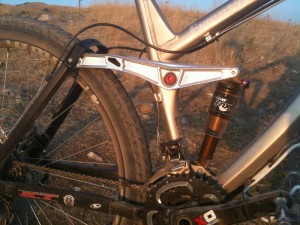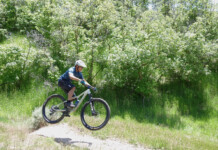
By Dave Iltis
This bike has made me a better mountain biker. Or made mountain biking better. Either way, the fun I’ve been having in the dirt has gone way up. Last summer, I was lucky enough to get an Ellsworth Evolution full suspension 29er.
I outfitted the bike with SRAM XO 3×10 throughout. Cockpit parts are a Loaded stem, Thompson seatpost, Cobb SHC 170 saddle, Easton EC70 27” wide carbon bars, and Lizard Skins logo grips. Shocks are the Fox Talas 29 120 mm travel in the front and Fox Float RP23 120 mm in the rear. Ellsworth handbuilt wheels and VeeRubber 2.4” Mission front tire and Speed-R rear tire round out the kit. I chose a nickel frame with a red ‘bling’ kit (seat collar, suspension pivots, bolts, etc.). The classic colors won’t ever go out of style. Ellsworth has a large number of colors to choose from.
The Evolution is made from tig welded aerospace 6061 aluminum SST tubes. The tubes are internally tapered and externally shaped to give the bike precise suspension alignment under all conditions. The bike is handmade from start to finish. Additionally the rocker arms are CNCed machined thus reducing weight and retains strength, stiffness, and good looks.

Ellsworth’s ICT (Instant Center Tracking) suspension is a four bar Horst link model that works to track the torque on the chain evenly thus eliminating the need for lockout. With the design, braking and suspension can function independently. By keeping the suspension always active, better control, efficiency, and traction result, along with a less fatigued rider. This explains why I feel good at the end of a ride and not beaten up by the terrain. The simplicity of the suspension system allows for a light bike. Mine weighs in at 28 pounds. Which is really light for a large frame, full suspension, 29er.
Ellsworth has been around since 1992, and all bikes are designed by Tony Ellsworth. The bikes are handbuilt in Ramona, California where the company strives to be environmentally friendly. They are also friendly in general, welcoming me to ‘the family’ of Ellsworth owners when I met the crew at Interbike.
Locally, Steve Goodman of Ellsworth dealer Hyland Cyclery built the bike for me. He did an excellent job. The bike has been working great so far attesting. Other local dealers include Salt Cycles, Mountain Velo, Moab Cyclery, Veloniq, and Cedar Cycles.
The bike I’m riding is a large. I’m 6’2”, and the bike fits well. The Evolution comes in a range of sizes from small to extra-large (in case you are an aspiring basketball star looking for a great riding bike).
The bike is the best mountain bike I’ve ever ridden. Full disclosure, I suck at technical riding. It’s never been my strong point. So, the biggest and most welcome surprise for me was how well it climbs and how easy it is to pick my way through rocks, turns, and obstacles when climbing. I’ve found the handling to be nimble and precise. Previous bikes I’ve had have wandered, leading me to plow into rocks on steep climbs. Or, I end up with my weight too far forward or to the side and end up losing traction with the rear wheel and walking to the next plateau in the trail. Not with this bike. I’ve consistently made it over obstacles and turns that would hang me up on other bikes.
Why is this? I’ve thought about this quite a bit, and think it’s a combination of several things. The 29er wheel size just rolls over rocks and bumps that a 26er gets hung up on (even with suspension). Combine the wheels with 2.4” tires, and 5 inches of travel in the front shock, and the bike rolls comfortably over everything.
Even with the larger wheels, the bike handles extremely well. This seems to be a combination of several factors. First, the design of mountain bikes has changed somewhat since my last bike. New designs tend to have longer top tubes, but shorter stems than bikes of a few years ago. The head tube angle is 72 degrees, leading to the nimble steering. Additionally, the wider bars (see article in the September 2012 issue of Cycling Utah), allow for better control. Finally, Ellsworth works to keep the center of gravity low for a 29er, resulting in clean handling at speed. All of these lead to a bike that rides fantastically well.
Speaking of the wheels, the bike came with a set of handbuilt Ellsworth wheels. They have so far been great – lightweight and bomber. The only issue I have with the wheels is that the spoke nipple size is not common, and it took a bit of time to find a properly sized spoke wrench (size 13). The rims have a 25 mm width. This results in a stiffer rim. It also results in a wider profile for the tire which gives a better contact patch and thus more traction.
There are a couple of minor items that I would like to see updated in future versions of the frame. The first is probably the most difficult. The bike has only 1 water bottle cage, mounted on the lower side of the downtube. This is an outcome several factors combined that result in a smaller front triangle that leaves no room for a cage in the triangle – 5” of travel, 29” wheel size, the need to prevent the wheel from hitting the frame when the shock is bottomed out, counterbalanced with the need for good standover height. But still, I would rather have a cage located in a spot where I can reach it more easily and the bottle stays clean. I’ll be riding more with a hydration pack this year as an alternative. The second is that the seatclamp works better when turned 180 degrees from the way it is designed. Lastly, the chainstays need a little bit more room for the very large tires that I’m running. According to Ellsworth the chainstays have undergone a redesign for 2013 and will accommodate a 2.5 tire, up from 2.35. It may be possible on an older frame to swap out the chainstay for the redesign, so may look in to that. Another upgrade available in 2013 is carbon fiber shock stays. These save 100 grams in weight and have a 270% increase lateral stiffness according to Ellsworth.
I have been quite happy with the component set as well. The Fox shocks, front and rear, are smooth and absorb big hits as well as small. The VeeRubber tires have worked great so far. The company has a history of making tires for other companies, but decided a few years ago to distribute under their own label as well. The rubber is quite sticky, and the casings supple. Cornering is smooth, probably a result of the rounded profile of the tires. And, while the knobs are lower profile than some, traction has still been great. I have particularly liked the 2.4” size – they are more comfortable and smooth than a lower profile tire, with not too much sacrificed as far as weight.
The SRAM XO mountain bike group is a winner. With the 29er, I went with a triple crank – 44/33/22, and an 11-36 cassette. With a larger wheel size, it is nice having the smaller gears. Shifting is flawless, the components light and solid.
The Cobb SHC 170 seat is quite comfortable. The cutout model I tried is a mountain bike specific seat that gains much of its comfort from a relatively flexible shell. Additionally, the narrow profile makes it easy to slide off the back of the seat on more technical sections. At 202 grams, it is light. The seat was not an original spec, but a welcome upgrade.
The Lizard Skins grips are both comfortable and precise – the lock ring keeps them from moving – and, they are a Utah based company. A side note on the grips – one can order these (from Lizard Skins) with custom lettering on the lockrings. I chose ‘Cycling Utah’, of course.
If you would like to try one out, contact your local dealer, or visit Ellsworthbikes.com for a calendar of local demo events.







